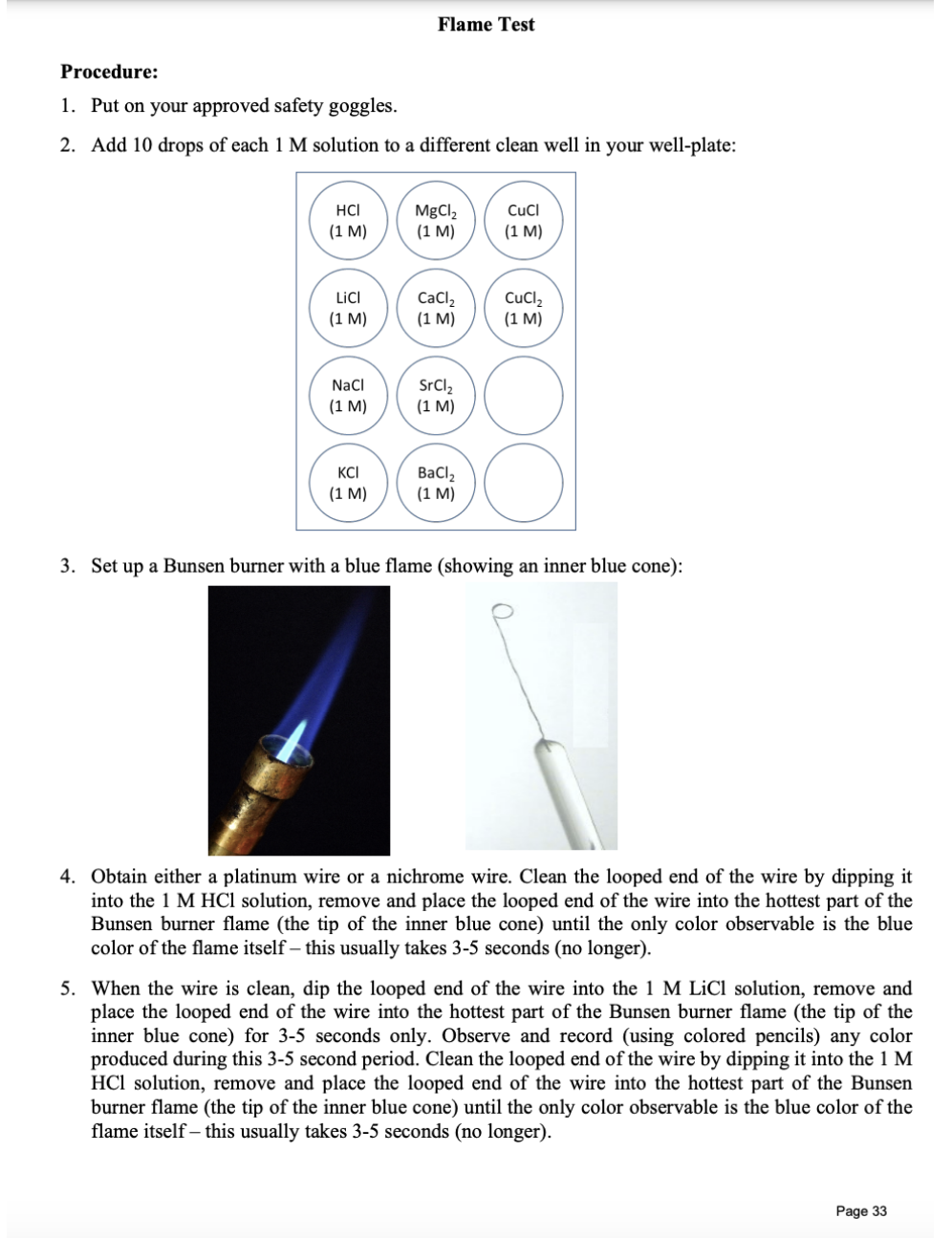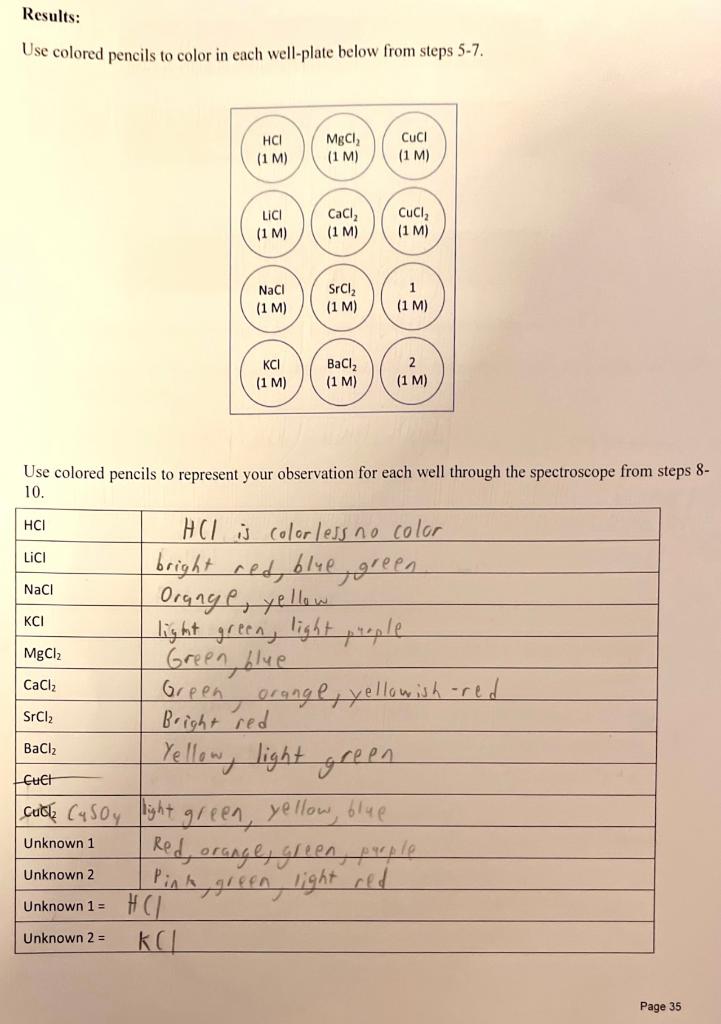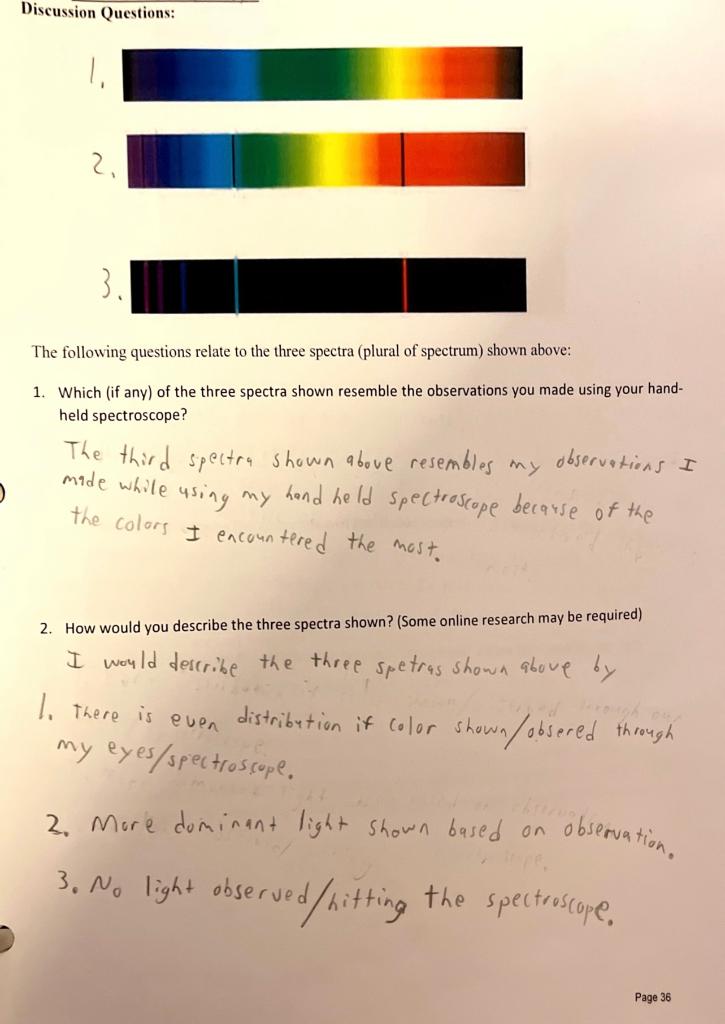Answered step by step
Verified Expert Solution
Question
1 Approved Answer
If an expert can please answer number 8., as well as the Conclusions: question, and as well as the Future questions: question from page 38.






If an expert can please answer number 8., as well as the Conclusions: question, and as well as the Future questions: question from page 38. If an expert can please answer these three questions by the end of today Wednesday January 25, 2023 or by Thursday January 26, 2023 before 2:00 pm or as soon as possible I would really appreciate it. Please and thank you in advance. This is for Chem 65.
Procedure: 1. Put on your approved safety goggles. 2. Add 10 drops of each 1M solution to a different clean well in your well-plate: 3. Set up a Bunsen burner with a blue flame (showing an inner blue cone): 4. Obtain either a platinum wire or a nichrome wire. Clean the looped end of the wire by dipping it into the 1MHCl solution, remove and place the looped end of the wire into the hottest part of the Bunsen burner flame (the tip of the inner blue cone) until the only color observable is the blue color of the flame itself - this usually takes 3-5 seconds (no longer). 5. When the wire is clean, dip the looped end of the wire into the 1MLiCl solution, remove and place the looped end of the wire into the hottest part of the Bunsen burner flame (the tip of the inner blue cone) for 3-5 seconds only. Observe and record (using colored pencils) any color produced during this 3-5 second period. Clean the looped end of the wire by dipping it into the 1M HCl solution, remove and place the looped end of the wire into the hottest part of the Bunsen burner flame (the tip of the inner blue cone) until the only color observable is the blue color of the flame itself - this usually takes 3-5 seconds (no longer). 7. Obtain one or two unknown solutions (1,2) from the lab instructor. Add 10 drops of each unknown 1M solution to a different clean well in your well-plate: 8. Repeat step 5 for each unknown solution. Unknown solution 1 and 2 will be the same chemical(s) used elsewhere in the well-plate. Identify the unknown solution(s) by comparing the flame color(s) to those already recorded earlier. 9. Repeat steps 4-8 using a hand-held spectroscope: 10. Use the spectroscope (which contains a diffraction grating) to observe the color of the flame for each of the solutions and unknown(s) in the well-plate. Use colored pencils to record the appearance of the flame for each solution as seen through the spectroscope. 11. Return all items used in this experiment and wash your work station and hands with soap and water. Finally, remove your safety goggles. Results: Use colored pencils to color in each well-plate below from steps 5-7. Use colored pencils to represent your observation for each well through the spectroscope from steps 810. The following questions relate to the three spectra (plural of spectrum) shown above: 1. Which (if any) of the three spectra shown resemble the observations you made using your handheld spectroscope? The third spectra shown above resembles my doservations I made while using my hand held spectroscope because of the the colors I encountered the most. 2. How would you describe the three spectra shown? (Some online research may be required) I woyld describe the three spetras shown above by 1. There is euen distribution if color shown/obsered through my eyes/spectroscope. 2. Nore dominant light shown based on observation. 3. N0 light observed/hitting the spectroscope The following questions relate to the spectrum above: 3. How would you describe the relationship between the wavelength of visible light and its frequency? I woyld describe the relationship between the wavelength ox visible light ind its frequency by saying that the longer the wavelength the the shorter the frequency qnd the shorter the wavelength the 4. How would you describe the appearance of the visible spectrum? Ionger the frequenct. The part/portion of the electromagnetic spectrum thit is visible to the himy eye is culied as the visiblespectrum. The weveleagth of the light that hunan eye can drtect lies in the rquge of 380nm to 700nm. Light at the lower end of the visible spectrum having a Inger. I woyld describe the relationship between the color of "spectrum isseen visible Ifght and its energy by saying that the frequency of ligdt is diectig. 9 viclex. proportions I to the energy. The higher the frequency of the visible light, the higher the energy. cm/s past a point "A". How long would it take for one wavelength of the light to travel past the point " A "? t=55.5cm/s555nm=55.5102m/s555109m=106s It would take 106 s for one wavelength of the light to travel past point A. Page 37 7. How would your answer to question 6 change (if at all) if the wavelength of the light was increased beyond 555nm ? If the wavelength of the light was increared beyond SSSnm time would increase. 8. What is responsible for the observations made during this experiment? Conclusions: Identify the cause of the flame test observations made in this experiment and write a short conclusion based on your observations and from any ideas introduced in the "Discussion Questions" above (1 paragraph). Future questions: What questions does do you have now you've finished this experiment? (ask at least 1 question)Step by Step Solution
There are 3 Steps involved in it
Step: 1

Get Instant Access to Expert-Tailored Solutions
See step-by-step solutions with expert insights and AI powered tools for academic success
Step: 2

Step: 3

Ace Your Homework with AI
Get the answers you need in no time with our AI-driven, step-by-step assistance
Get Started


